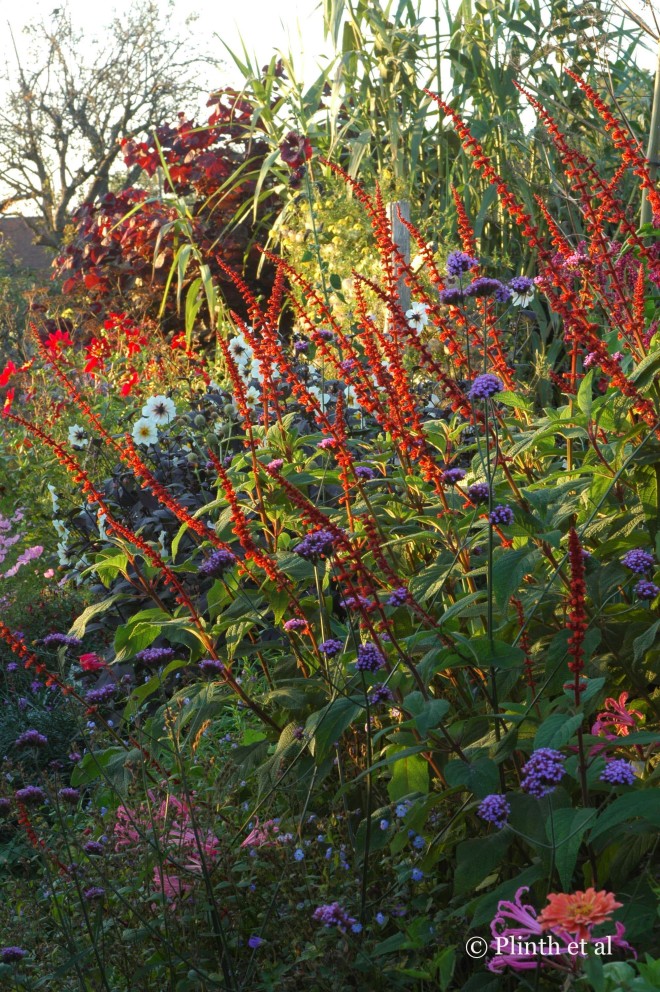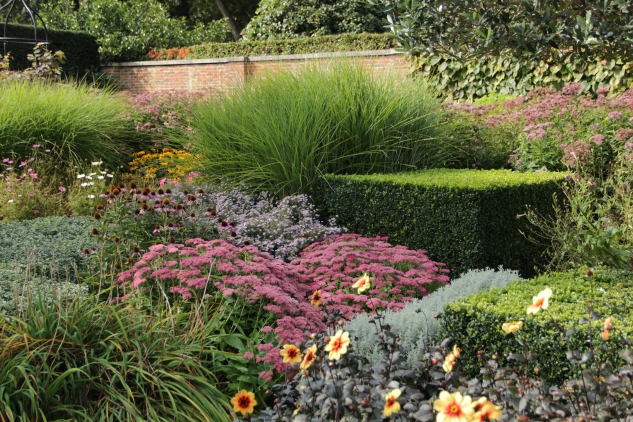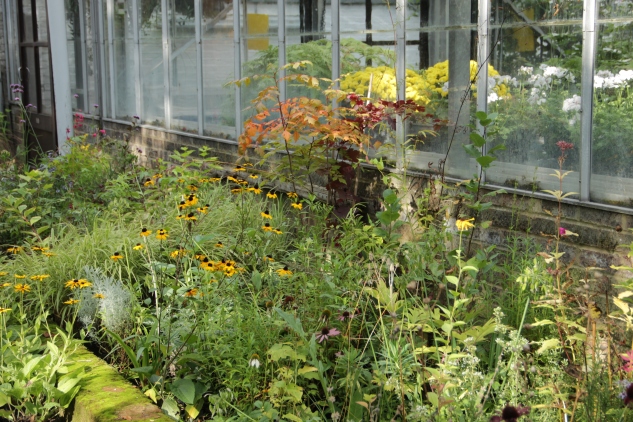An excellent designer and passionate plants-person, meeting Gabi is a memory that remains clear in my mind. Arriving at Great Dixter for the first time from the U.S., in the darkness of night during a horrible downpour, was an experience. By the time I made it down the long front path to the huge ominous house, with the crooked porch in front of me, I was sopping wet. After some heavy knocking, Gabi opened the huge wooden front door, greeting me warmly. Once inside the house, it was all another world to me, like stepping back in time. Gabi led me to a roaring fire in the Solar upstairs and brought out a tray of delicious homemade soup and tea. As I ate and warmed up, adjusting to the surroundings, Gabi could see and understand what was going on in my mind, the excitement of it all, since she too had been a newbie at Dixter once too. It was a surreal experience that night and from that wonderful moment on we have remained friends. – James
 Hi, Gabi! That story always makes me smile, thank you again for your kindness that night. As the first in the Foreign Gardeners series, can you tell others what country you were born and where you decided to move to?
Hi, Gabi! That story always makes me smile, thank you again for your kindness that night. As the first in the Foreign Gardeners series, can you tell others what country you were born and where you decided to move to?
Hello, I am Gabriella Nemeth and I am from Hungary and moved to the United Kingdom.
How long have you been living in the U.K. now?
I will be living in the U.K. ten years now this March.
Describe to us the beauty of the landscape in Hungary, your homeland, and your memories from your time there.
I was born on the Great Hungarian Plains. The landscape is flat. Flatter than anyone can imagine. The open land, the sand which moves around, scorching summers and extremely cold winters and very poor soil makes it difficult to grow anything. But the natural habitat, the most western edge of the Russian Steppes creates the most unique, colorful ever-changing carpet in the land.
I loved wandering through these meadows searching beauty which hid in the details of Verbascum flowers or the delicacy of the bloom of Stipa borysthenica. I marveled at the wonder of how a small lichen creates a growing surface for moss, later a sedum, then a grass, which later gets replaced by perennials and later the beautiful silver poplars; the ongoing succession of plants.
I really miss walking barefoot in the warm sand in summertime, and catching the scent of flowering Robinia pseudoacacia and Asclepias syriaca.

When did you decide to make this change and why did you move to the UK?
I have studied Landscape Architecture in Hungary and after finishing University with a Masters in 2005. I was made to be unemployed and did odd jobs for nearly 2 years due to my home country’s economic and social situation. At the same time, the lack of encouragement for young professionals to express themselves, the lack of appropriate jobs and the suppression of women who have a desire to build a career, resulted in a desperate move to find my own path. For years I was extremely keen to find a job in garden design or landscape architecture but my interest had been diverted more to the importance of plants and understanding their life cycle, appearance, texture, colour, being the most important building elements of garden design. I finally realized I wanted to learn more about succession planting and the proper and artistic use of these elements in the garden.


In the summer of 2006, I received a lovely gift from my best friend in Hungary( who sadly passed away in 2012, aged 33, due to cancer). She visited the UK during that summer and brought me back an copy of Gardens Illustrated magazine. I read an article about a nursery called Dove Cottage Nursery and I picked up the courage to write a letter, to ask them about a few weeks of training. They were so kind and helpful and sent me a response very promptly. They couldn’t take me on but they suggested to contact Great Dixter and Fergus Garret. It was November 2006 when I sent out my email to Fergus and for my biggest surprise and shock he replied within 2 weeks and asked me when would I like to come and how long I would like to stay. This email was the key for my future! I decided to immediately leave my part time librarian job and fly out in March 2007 for a 3 month apprenticeship. Shortly after my arrival I felt that this is the place and country where I was called to. A few weeks before my finish date I asked Fergus if there would be a job a for me in the future since William, the vegetable gardener, was leaving and they would have a vacancy, which I was then offered. I accepted it but on the result of this I had to make some very hard life changing steps in my private life. It was the most difficult and the same time the easiest decision to make. It has taken years to settle all the waves I stirred up but it was worth it.

Quiet mornings in the vegetable garden at Great Dixter

Can you explain to us a bit about your current job?
In 2010 I moved on from Great Dixter with a plan to find a part time gardener job and concentrate on garden design and build up my own clientele in garden maintenance. Since 2012 I have gone fully independent and became a freelancing professional gardener, a designer with a variety of jobs in the UK and abroad, including gardening advisory and floristry.
I had to go through a though learning curve over the last 3 years. I am a freelance head gardener at 2 private homes in two different counties in the UK, supervising independent contractors to complete all the tasks needed in the highly maintained gardens and am also responsible, personally, for the border maintenance, vegetable gardens, lawn care etc.
I have a very versatile job, which keeps me highly occupied, since I have a very long commute between my jobs which means a lot of driving time beyond working hours. I definitely haven’t got a 9 to 5 job but I have a lot of variety, a lot responsibility and lot of reward from my gardens as a result of long working hours and hard work.
 How did you happen to find your current job?
How did you happen to find your current job?
Both of my clients found me, which is very surprising, after all the job applications I sent out and interviews I attended. My client in Wiltshire has been the best of all my career, I was recommended to them by their garden designer and I have been working for them for more than 4 years. A record for staying in the same job for so long, but it proves that it takes time to find the right kind of people to work for and the right kind of garden which needs me…
The other clients, in Berkshire, found me through an agency I was registered with. I have been working for them 2 years now. An interview with prosecco and prosciutto resulted in a great working relationship, together building a fantastic garden.
Would you say there are benefits to being a gardener living abroad?
Yes, I am living in heaven for any gardener/horticulturist. The UK is the place where everyone is so passionate about their green places, you can grow almost anything from all over the world and my job is the most appreciated here in the UK.
As a foreigner living abroad it’s not always easy at times. What, if any, have been some difficulties you’ve encountered during you time living in the UK? What have some of the struggles been?
Some of the struggles…a lot really…it’s part of getting stronger and resilient and succeeding.
In general, when I moved to the UK I didn’t have a car but from my first salary I bought a bicycle. Great Dixter is at least 10 miles from the nearest town and the public transport can be unreliable and scarce. I needed to get to places. I soon realized everyone uses cars to get around and has little respect and attention for a cyclist. Later when I got a car I encountered the overcrowded motorways and traffic jams which now my daily experience. So bad public transport services, little respect for environmentally friendly ways of getting around and too many cars.
Loneliness, lack of family or old friends support, new language, living financially on the edge and taking very big risks all alone,the physical challenge of my job, being in pain and being soaked in the rain for days in and out. The language and cultural differences were hard the first few years. I found it very hard to realize that it’s much easier to make friends with people from abroad than with the locals…it is still an ongoing difficulty. I have more friends abroad who I keep in touch more frequently than with people from Britain.
Doing very insignificant jobs for years to finally make a tiny step up, being turned down from jobs many times, getting a job which didn’t suit me and leaving it, but because of the financial dependency I had to carry on working, sometimes with people who humiliated me. I had to learn that people like to take advantage of others, especially those in vulnerable positions. I definitely have been used over the years, as result of the hard working Central European attitude. I learned how to and how not to do things, manage staff, etc… But all this made me very strong and I know it was worth it. And the rain is something which takes time to get used to, especially when one comes from a country where life stops at the first rain drop.

On the flip side, there must also be some surprising change that you have welcomed and enjoyed. What would those be?
I think the love of plants and gardens was the best surprise. I love the climate regardless of it’s raining or not. I also love the countryside and the coast which is on a sunny day is unbeatable in beauty.
Mostly I have found so invigorating is the encouragement I get from the people to pursue my dream and career, to follow my heart and be myself, do my dream job and live my dream life. Fantastic surprise after years of suppression.

Moving to a new place can have its challenges, what preparations did you take to prepare yourself for this move from Hungary to the UK?
I was not aware of it but I have spent a lot of time and effort and money on learning English in high school…it was more like a pride thing…I was the only one when we started at high school at age 12. I had to write an introductory test which I failed with scoring 0 points, that I couldn’t stand and instead of despairing I took up extra language lessons and within a year I was in the advance class! So, yes it was all worth it…
Also my first cash in hand jobs in Hungary were garden maintenance for a Greek-English family and a bunch of Americans, though I didnt know it was the prep for the future.
What advice would you give to others who are going to be making the same sort of life changes similar to your situation?
Seek and knock on the doors, be brave, take risks, try, don’t give up, try again and again…and again… Wait, work hard and you will succeed.
If you could go back and give your younger self some advice for theses changes, what would you want to tell yourself?
I think I would have told myself to be more patient with certain things but on the other hand don’t put up with bad employers, situations, circumstance as long as I did but it’s easy to be wise, the challenges of the moment always dictates your acts more than wisdom.
Mainly I would encourage my younger self to discuss and communicate more. I think that helps the most to find yourself out, to find yourself, your dream job and life.
Having lived in the UK for a while now, tell us some of the greater memories you have made so far…
I think taking off the ground in Hungary with the plane in March 2007, it felt like being pulled out from a sticky mud hole which almost swallowed me up… Driving up to Great Dixter first time which was surrounded with spring flowers and occupying my room with a 4 poster bed…yeah…unforgettable….unbelievable. Meeting you Jimmy! On that spooky windy November night! Makes a smile on my face each time I think of it with all the trimmings of story of that day. And leaving Dixter, packing up my car and driving into the unknown future again. To 3 years ago the feeling of moving into my flat, which I rent, but it is only mine! Walks in the countryside wherever I have been living over the last 8 years are some of the most wonderful moments of my life in Britain.

Turning back to gardens, tell us your new favorite plant that you can now grow that you weren’t able to before?
Compared to Hungary I’m so happy to be able to grow healthy old English roses and sweet peas, on the veg line artichokes and brassicas. All very traditional but still a special treat for me.

Thank you for agreeing to be interviewed and for sharing your story with everyone. If you would like to reach out to Gabriella, ask a question please do so by commenting below or see and know more about her work please click on the links provided below. Thank you Gabriella! – Plinth et al.
Website: Gabriella Gardens
Facebook: Gabriella Gardens

























































































You must be logged in to post a comment.